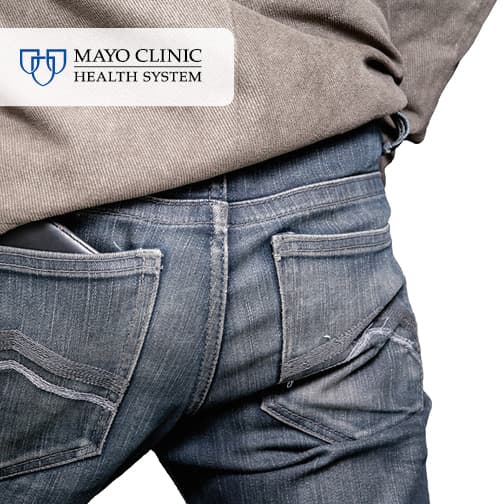Posted By

Alicia Ogle, A.P.N.P., R.N.
Obstetrics & Gynecology (OB-GYN), Reproductive Endocrinology (Fertility)
Recent Posts
-
 Speaking of HealthFertility considerations in cancer treatment: Preserving hope for the futureJuly 18, 2023
Speaking of HealthFertility considerations in cancer treatment: Preserving hope for the futureJuly 18, 2023 -
 Speaking of HealthTrying to get pregnant? Select a lubricant most helpful for spermNovember 17, 2022
Speaking of HealthTrying to get pregnant? Select a lubricant most helpful for spermNovember 17, 2022 -

Using ovulation tools to predict fertility

If you search for ovulation tools online, you'll quickly find that all the options can be a little overwhelming. Here's a breakdown of ovulation and what to know about tracking it.
Ovulation and fertility
Women are most fertile around the time of ovulation, which is when the body releases a mature egg from the ovary. After the egg is released, it travels to the fallopian tubes, where it can be fertilized by sperm.
Once released, the egg has 12 to 24 hours to become fertilized. On average, sperm can survive inside a woman's body for three days, and up to five days, to fertilize the egg.
The chance of getting pregnant is highest when live sperm are present in the fallopian tubes during ovulation. So how can you tell if you're ovulating?
Does the body give signs of ovulation?
Most women will ovulate within four days of the middle point of their menstrual cycle. One way to track this is to use a calendar to track the length and midpoint of the menstrual cycle.
Signs of ovulation include:
- Change in cervical mucus
Before ovulation, there may be an increase in clear, wet and slippery secretions from the vagina. After ovulation, the secretions become thicker and cloudy or may go away. - Change in body temperature
Basal body temperature is the body's temperature at rest, and it increases slightly during ovulation. Tracking basal body temperature every morning before getting out of bed can indicate a pattern in the temperature. Women are most fertile during the two to three days before basal body temperature rises.
If watching for changes in cervical mucus or tracking basal body temperature aren't effective, some people use ovulation predictor tools to track the rise in hormones that occurs before ovulation.
Can I use an ovulation app, or should I use an ovulation kit?
When couples are trying to get pregnant, they can start with an app. Each woman has different needs when it comes to predicting ovulation. All women should track their cycles, and a great place to do that is with an app. After details about periods are entered, the app will give the fertile time of the cycle. Having intercourse at least every other day around their most fertile time is recommended.
If a couple has been trying to get pregnant for more than six months and hasn't been able to conceive, an ovulation kit, in addition to using the app, may be helpful.
Why should I use an ovulation kit?
Ovulation kits look for a rise in the luteinizing hormone, which causes women to ovulate and release an egg. When a woman is ovulating, she is at the most fertile part of her cycle and is the most likely to get pregnant. Being aware of this can help increase a woman's chances of getting pregnant.
When should I use the ovulation kit?
Typically, a woman's menstrual cycle is 24 to 38 days. A standard reference timeframe for a menstrual cycle is 28 days. With a 28-day cycle, a woman will ovulate on day 14 or 14 days before her next period starts. With a shorter or longer cycle, the ovulation day varies.
Start testing on the first day that indicates a fertile day on the ovulation app, and test your urine once daily. A positive result would indicate to have intercourse that day and the day after.
How do I read the ovulation kits?
Like pregnancy tests, stick ovulation tests display indicator lines, with one being a control line. If the second line is as dark or darker than the first line, this indicates you will soon ovulate. These tests can be more difficult to read but are the least expensive.
Some digital ovulation tests give "yes" or "no" responses using words or images, such as smiley faces, to tell that you'll ovulate soon.
Other digital tests may tell how fertile you are by providing your fertile days, which are also indicated with an app. Look for the peak as a positive result, indicating that you'll ovulate soon.
Not getting the results you're looking for?
Ovulation kits aren't perfect. False positives or consistent negatives can happen. This may be caused by eggs not being released, excessive amounts of the luteinizing hormone or another ovulatory dysfunction. If you're concerned about your results, contact your health care team to discuss your fertility.
Learn more about ways to improve fertility:
- To become pregnant, the complex processes of ovulation and fertilization need to work just right. Read tips to improve fertility.
- It seems like there's endless advice on what to do when you're trying to get pregnant, but what information is accurate? Read about common fertility myths.
Alicia Ogle is a nurse practitioner in OB-GYN in Eau Claire, Wisconsin.



